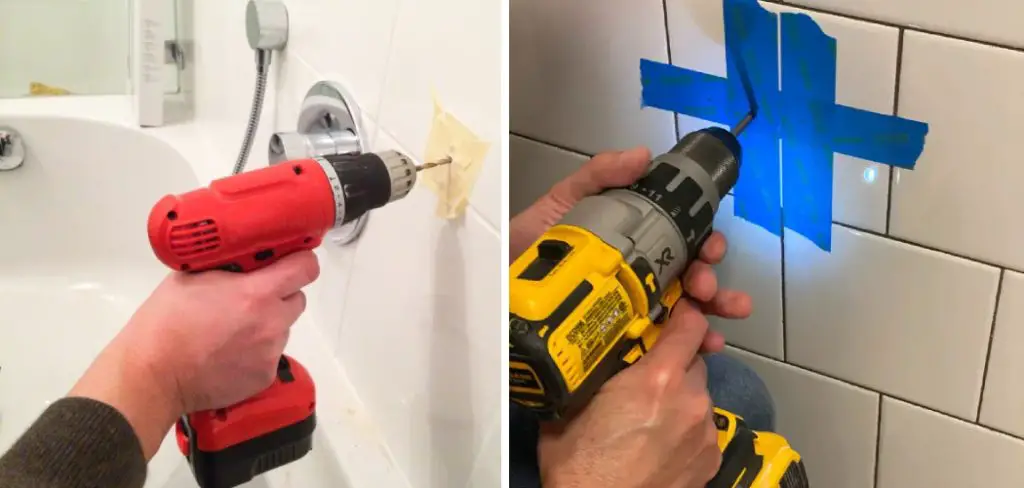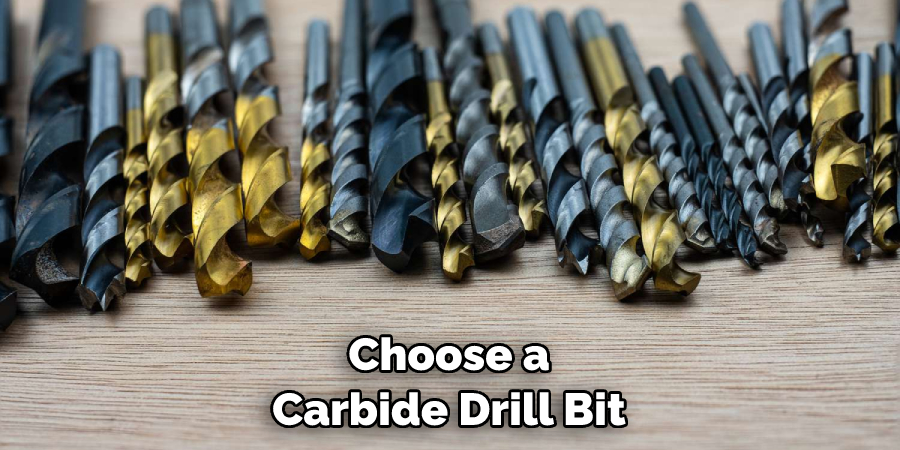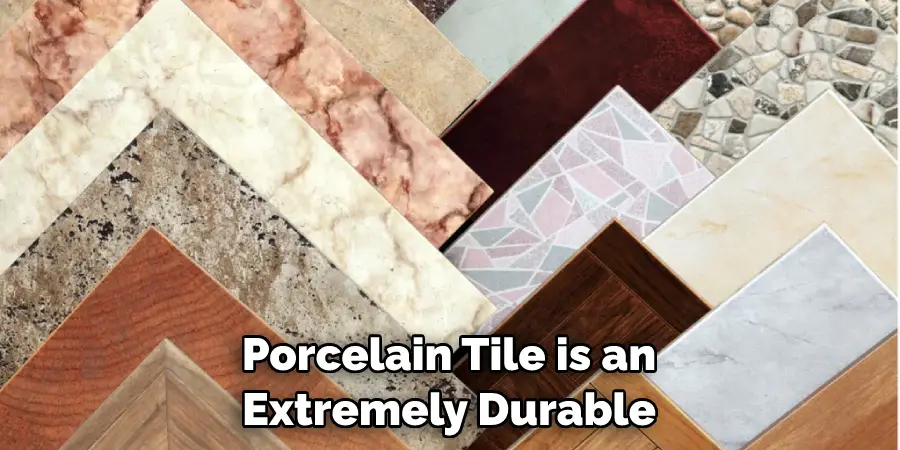Drilling a hole in porcelain tile is a great way to install fixtures such as towel bars, toilet paper holders, and shelving. However, it can be challenging. Porcelain is one of the hardest materials used for tiling and can be difficult to drill through without the proper technique and tools.

Drilling a hole in porcelain tile is often seen as difficult, but it can be made much easier with the right tools and techniques. When done correctly, you’ll have a neat, clean hole that won’t damage the surrounding tiles or cause any other problems.
Plus, drilling through porcelain ensures a strong bond between the fixture and tile, resulting in a secure installation lasting for years. You can find step-by-step instructions on how to drill hole in porcelain tile in this blog article.
Tools You Will Need
- Safety glasses
- Drill bit for masonry/ceramics
- Cordless drill
- Pencil
- Tape measure or ruler
- A wet saw with a diamond blade
- Vacuum cleaner
- Tile nipper (optional)
- Drill guide (optional but recommended)
- A high-quality carbide screw tip
Step-by-step Instructions for How to Drill Hole in Porcelain Tile
Step 1: Inspect the Tile
Before you begin, check to see if the tile is in good condition. Make sure there are no cracks or chips and that it’s not broken in any way. If it is, drilling a hole into it could cause further damage.
Step 2: Mark Your Spot
Use a pencil to mark where you want the drill hole to be. This will help you keep track of where the drill bit needs to go when drilling. Clamp the tile down onto a stable surface like a workbench or table. This will ensure that the tile doesn’t move around while you are drilling, which could cause the hole to be off-center or too large.
Step 3: Use a Carbide Drill Bit
Choose a carbide drill bit that is the correct size for your needs. This type of drill bit is designed to cut through hard materials like porcelain tile, making the job easier than using other types of bits. Set the drill to low speed. The slower speed will help you keep more control over the drilling process and make it easier to get the hole in the right spot.

Step 4: Place Drill Bit on Marked Spot
Carefully place the drill bit on your marked spot and start drilling slowly. When you start, apply light pressure and then gradually increase the pressure as you go. Don’t try to drill a hole all at once. Instead, take short breaks between drilling to let the bit cool down and avoid applying too much force.
Step 5: Remove Bits of Tile from the Hole
Once you have drilled your hole, remove any bits of tile from the hole with a vacuum or brush. Once you have finished drilling, carefully remove the clamp and inspect your work. Ensure the hole is in the right spot and not too large or too small.
Step 6: Install Fixture
Finally, install the fixture that you wanted to drill a hole for. This could be a showerhead, plumbing pipe, or anything else that requires drilling into porcelain tile.
The steps above will help you properly and safely drill a hole in porcelain tile. If done correctly, this should ensure that the job is done right the first time and that the hole is exactly where you want it.
Safety Precautions for How to Drill Hole in Porcelain Tile
- Wear eye protection while drilling – flying debris or dust particles can damage your eyes.
- Put on a pair of heavy-duty gloves to protect your hands from the intense heat the drill bit generates.
- Clamp down any tiles you plan to drill into before starting to prevent them from shifting during drilling and possibly damaging the tile or causing an accident.
- Use a small drill bit and slowly increase the size of the hole as you go along. This will help you make a smooth, even hole without chipping away at the edges of the tiles.
- Remember to use cooling lubricant when drilling into ceramic or porcelain tiles. Otherwise, they’ll heat up and crack.
- Regularly check your drill bit’s temperature to ensure it isn’t overheating. Replace the bit if necessary.
- Use a piece of scrap tile underneath the hole you’re drilling, as this will help absorb some of the impact from the drill and reduce any damage to the tiles or flooring beneath them.

Drilling into porcelain tile can be daunting, but it doesn’t have to be. You can ensure your job is done safely and efficiently with the right tools and safety precautions.
Is It Safe to Use Water When Drilling Through Porcelain Tile?
Water can cool the drill bit when drilling through porcelain, but it’s only sometimes recommended. If there isn’t proper ventilation, the steam generated by water can cause problems with your drill or the tile itself. Additionally, if drilling in a wet area, such as a bathroom, you should avoid using water altogether to prevent electrical hazards.
Instead, use a cooling lubricant such as mineral oil or WD-40 to help the drill bit stay cool and reduce any risk of damage to the tile. This is especially important when drilling into glazed porcelain tiles, which can easily crack if exposed to too much heat.
Drilling with water should only be done in well-ventilated areas and with a drill bit specifically designed for use in wet environments. Otherwise, sticking to dry drilling or using cooling lubricants instead is best.
Are There Any Special Techniques That Can Help You Drill Holes in Porcelain Tile More Efficiently?
Yes, certain techniques can make drilling holes in porcelain tile easier. First, it’s important to use a high-quality drill bit specifically designed for hard surfaces such as porcelain tile. In addition, when starting the hole, you should apply steady and even pressure while using a slow rotational speed.
Once the bit has penetrated the tile, you can increase the speed slightly to complete the hole. It’s also important to keep a steady hand and maintain control of the drill. Doing so will help ensure that you create a clean, precise hole in your porcelain tile.
Lastly, when drilling multiple holes, it may be helpful to use an adhesive template to ensure all the holes line up accurately. This will also help you avoid creating any additional chips in the tile.
How Should You Clean Up Chips From Drilling Porcelain Tile?
Once you’ve finished drilling your porcelain tile, cleaning up any chips or debris created from the process is important. The easiest way to do this is with a vacuum. This will help remove any dust or small pieces of porcelain that could interfere with the installation of your fixtures.

For larger chunks, you may need to use a damp cloth or sponge and soapy water to wipe away the debris gently. You can begin the installation process once all the chips and debris are removed.
Is There Any Special Aftercare You Should Be Aware of When Working with Porcelain Tile?
After you’ve finished drilling and installing the fixtures in your porcelain tile, it’s important to properly care for your tiles to keep them looking their best. You should clean them regularly with a soft cloth and mild detergent to do this.
Additionally, it’s important to seal the grout lines between your tiles to prevent moisture from seeping into the seams. Sealing the grout will also help protect against dirt and bacteria buildup, allowing you to keep your porcelain tile looking new for years.
What Are The Benefits of Using Porcelain Tile?
Porcelain tile is an extremely durable and versatile material that can be used for a variety of applications, both indoors and outdoors. It’s also resistant to staining and easy to clean, making it ideal for use in high-traffic areas such as bathrooms and kitchens.

Additionally, porcelain tile is easier to drill into than other types of tile, so it’s a great choice for those looking to install fixtures in their homes. Finally, porcelain tile is available in various colors and patterns, making it easy to find one that fits your unique style.
Conclusion
Drilling holes in porcelain tile can be a daunting task for those who are unfamiliar with the process. However, you can easily create precise and clean holes by following the tips outlined in this article and using a high-quality drill bit specifically designed for hard surfaces such as porcelain tile.
Also, proper aftercare, such as cleaning your tiles regularly and sealing the grout lines between them, will help keep your porcelain tile looking new for years.
With its versatility and durability, porcelain tile is a great choice for those looking to add style and functionality to their homes. Reading this post has helped you learn how to drill hole in porcelain tile. Make sure the safety precautions are carried out in the order listed.
